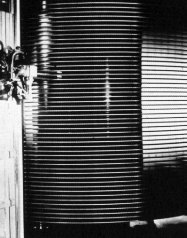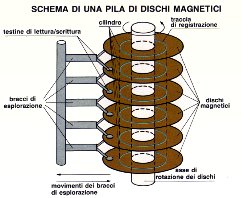|
Data storage and elaboration
In the first calculation machines the memory was made by cathode-ray tubes, or by magnetic drums which roll at high speed. A series of magnetic heads print the data and the directions on the drum's cylindrical surface magnetized points-shaped and then it "reads" them in few thousandth of seconds.
About in 1955, in the most developed calculation machines the drum memory is replaced by million of ferrite nucleus which enable to set in small space a bigger number of data and to read them one million times quicker.
The cores are microscopic magnetic little rings, which have a diameter of a few tenth of millimeter and they are crossed by two electric wires which are perpendicular among them: at the crossing of the impulses which come from the data' intake unity, each core can be magnetized in two opposite directions and so it can set conventionally the 1 or 0.
The third electric wire is able to take the set information recognizing the core and sending an impulse in few thousandth of second.
The execution of the arithmetical and logical operations is developed inside the central unity through circuits made by electronic tubes, the use of which is the technological characteristic that marks the "first generation" calculation machines.
The empty tube, known also as "valve", is in its simpler form a glass bulb in which it was practiced the empty and it contains the two heads of an electric circuit.
According to the applied tension, the tube enable or not the crossing of the elctric impulses, marking so conventionally the symbols 1 and 0.
This function, which is similar to the traffic-light one that rules the cars crossing according to the sign of "go" , was developed in the electromagnetic calculation machines by the relays: the exchange time of an empty tube is only of a millionth of second, compared to the hundredth of second asked by the opening or closing of a relay.
The memory, which stores up inside the data and the directions, is not able to understand the meaning of the contained orders.
Their interpretation is given to the control unity which searches for the ferrite cores' contents and it uses the various position "1" and "0" to obtain opportune impulses of current, which at their time will produce the asked effects at electronic speed.
Every command which is introduced in the memory is composed by two parts: the first series of impulses show which is the operation to do ; the second part shows the position of the memory in which it is possible to find the necessary data to do the operation, that means its "address".
The issues of the elaboration are materially given by the calculation machine through the emission data' unities.
The simplest among those devices is the punching cards which provides for the conversion of all the issues from the binary form into that one more comprehensible to mankind: a series of drifts moved by opportune impulses which are sent by the central elaboration unity, trasform the issues in perforations on cards.
About in the second half of the fifties the possibilities to apply the calculation machines were more and more amplified by the use of auxiliary external memories.
Ribbons, disks and magnetic drums set a lot of informations to keep permanently or to use rapidly during the elaboration phases.
While to read the set information on the ribbon is necessary to develop it from the beginning to the point which interests, instead the magnetic disks are memory unities at direct admittance which enable to reach instantly every set data.
For the first time in 1956 on the IBM 305 RAMAC SYSTEM, (RANDOM ACCESS MEMORY ACCOUNTING COMPUTER), it was presented the disks memory which is similar to a juke-box.
A pile of metallic rotating disks stores the informations on its surfaces along the concentric tracks and magnetized point-shaped.
The magnetic disks are able to locate and to revise in a fraction of second some informations among the large number of filed data and their availability gives a big impulse to the application of the calculation machines.
|

















